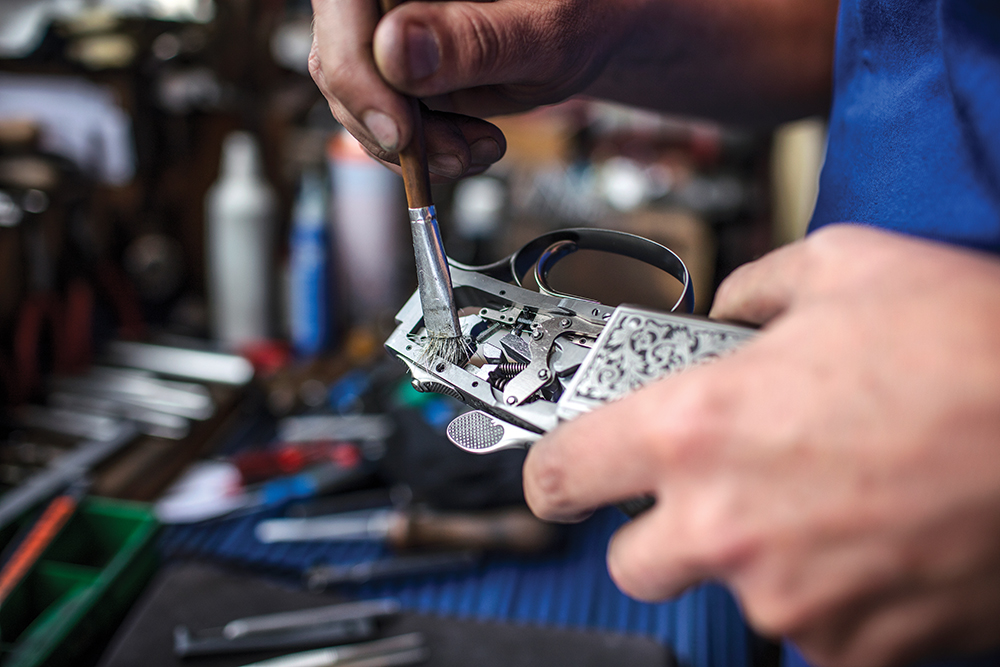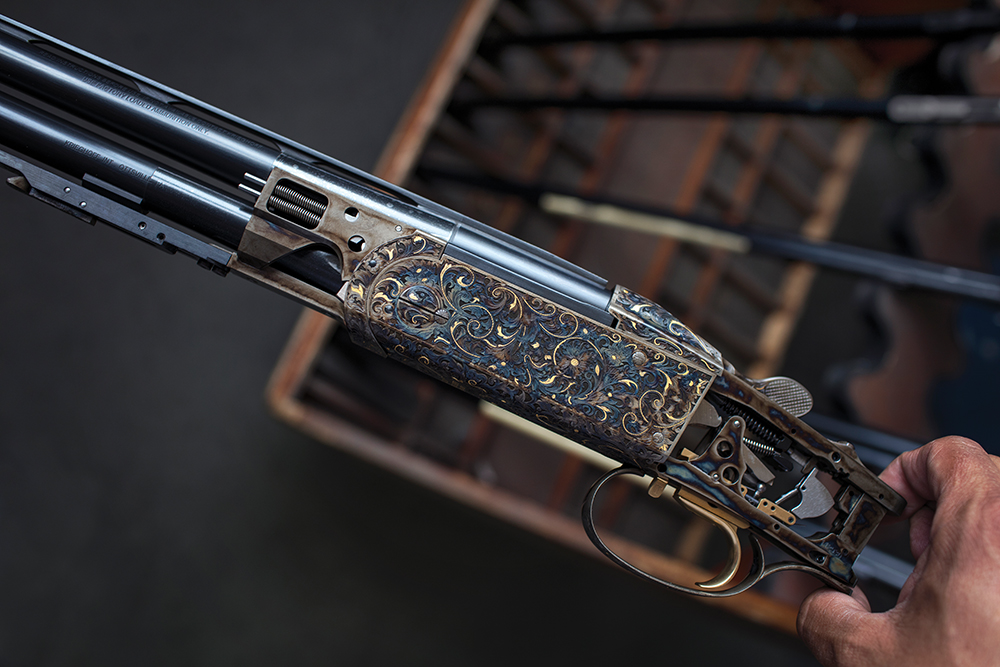Krieghoff Für Alles

Alongside two blue banners bearing the Krieghoff name, an American flag fluttered as we arrived at the gunmaker’s factory in Ulm in southern Germany. “We flew it to mark your arrival,” said Ralf Müller, Krieghoff’s vice president and marketing manager.
Flattery, perhaps, but a display also freighted with symbolism. No German gunmaker has its modern history so tightly entwined with the United States as Krieghoff. When American armies marched across Germany in spring 1945 they swept in to Suhl, a town in the province of Thuringia, home to many of the nation’s gunmakers—including Sempert & Krieghoff, cofounded in 1886 by Ludwig Krieghoff.
The western Allies had agreed to hand Suhl to Soviet occupiers in July ’45, but not before they evacuated some of the owners and employees of its leading gunmakers, including those of Sempert & Krieghoff.

“We were considered ‘human assets,’ too valuable to fall behind the Iron Curtain,” said Dieter Krieghoff, Ludwig’s great-grandson and today one of the firm’s three managing directors, as well as president of Krieghoff International, the US-based subsidiary he founded in 1986. Dieter pointed to a photograph taken in 1947, showing a massive plume of smoke rising from the old factory after the Soviets took root in Suhl. “They stripped the equipment, shipped it to Russia, then blew our factory up.”
In the meantime, the withdrawing Americans took Heinrich Krieghoff—Dieter’s grandfather—and some workers west to Heidenheim, a town 45 miles north of Ulm. Heinrich, joined in ’46 by son Heinz-Ulrich (Dieter’s father), opened shop in Heidenheim, where they stayed until 1950, then relocated to a new industrial zone surrounding Ulm, a city on the Danube gutted by Allied bombing but rebuilding with postwar aid. The business reformed as H. Krieghoff GmbH, making only air guns at first, but soon after returning to the drillings and combination guns that had been the old firm’s specialty before its stint as an armaments manufacturer during the war.
Then, in 1954, an American came calling—with a proposal that would, over the next half century, transform Krieghoff from a gunmaker popular mainly in Mitteleuropa to what today is an international brand with growing global sales.
That idea, presented to Krieghoff by an American entrepreneur and his German partner, was to manufacture Remington’s discontinued Model 32 over-and-under in Ulm and sell them in the United States. Remington had introduced the 12-gauge target gun in 1932 (hence its name) and had halted production in 1942, but even during a decade disfigured by the Depression and world war more than 5,000 were sold, and the gun remained popular with American trap and skeet shooters. It was mechanically complex and relatively expensive to produce, however, and after the war Remington showed no interest in resurrecting it.

The entrepreneurs, who’d go on to do business as the Europa Corporation, acquired the rights to make the gun, Krieghoff decided they could build it, and in 1957 America’s Model 32 was reborn as the K-32. By the early 1970s it was the dominant competition over-and-under with American clay target shooters, and in 1976 a K-32 was used to take a gold medal in trap at the Montreal Olympics.
Krieghoff has since refined the K-32 into the much-improved K-80. Today it is one of the world’s most sought-after competition shotguns, not only in the US but also in Europe. And, thanks to the 2012 introduction of the lighter and more nimble Parcours models, 12-gauge K-80s (and little sister 20-gauge K-20s) are making inroads into the over-and-under game gun market.
“I’ve never seen our order books as full as they are now,” Dieter said as we discussed Krieghoff’s history in its boardroom. At one time, he noted, about 70 percent of its production went to America; now it’s closer to 50 percent, “not because of declining orders from America, but because the world has discovered Krieghoff. Yesterday, a shooter flew in from England; today we have them arriving from Switzerland and Finland.”
As I learned during my two days in Ulm, the company’s success stems from several sources, some of those particular to Germany. The nation’s prowess in engineering and manufacturing—which at Krieghoff fuses high-tech machining with old-time Handwerk—lives up to its vaunted reputation. Moreover, Krieghoff’s business strategy—from hiring apprentices to promoting its guns to protecting its dealers and, ultimately, to pleasing its customers—is planned for the long run and executed with Germanic thoroughness. Said Dieter: “Nothing at Krieghoff happens by accident.”

But success has also been built upon the versatility of the original American design. While it is long-lined and angular, the action has a very low profile, which retards felt recoil, and the sliding bolt makes changing barrels easy. A drawbolt, likewise, secures the stock, which simplifies fitting new wood. The upshot is a mutable, almost modular gun, competition proven and adaptable for any clay-target sport.
From the start of the ’60s through the early ’70s, the K-32 was the competition over-and-under for American-rules trap and skeet shooters. Then Perazzi came along. As the ’70s wore on, the racy Italian upstart began stealing market share in the US, and dominating international trap and skeet elsewhere. By late in the decade, Krieghoff inventory was stacking up in the States. The K-32 seemed stodgy and stale.
Only it wasn’t. By 1978 Krieghoff was consulting with America’s top trap and skeet shooters and was at work improving the old design—with a better, adjustable trigger, more ergonomic stock shapes, and a slew of new rib and barrel configurations, including the innovative “Unsingle” single-shot trap barrel. Dieter, born in 1950, earned an MBA from Saarbrücken University and joined the company in 1976, assisting the new gun’s development, especially its new trap and skeet stocks.
Krieghoff released the K-80 in 1980, and the trajectory of the firm has climbed since, especially after Dieter emigrated to North America in 1979, first to work with a Canadian importer and in 1980 to begin direct imports to America. “After this our sales in the US mushroomed,” he said.
Krieghoff continues to refine its gun, and a characteristic of its methodical approach to engineering means most of those improvements can be retrofitted to existing K-80s. “We can even ‘K-Eighterize’ all but the earliest K-32s,” said Dieter. “Our customers never feel their gun is obsolete, so they don’t go looking for a better mousetrap every couple years.”
Krieghoff uses high tech to design and manufacture components, then skilled hands to assemble them into guns. In a cavernous room singing with the scree of cutters machining steel, we watched actions aborning in a large Hermle CNC machine. Each basic frame takes about 90 minutes to make—instead of days as of old, and now they are made to tighter tolerances. Other CNC units were busy with monoblocs and internal components.

The nation’s prowess in engineering and manufacturing—which at Krieghoff fuses high-tech machining with old-time Handwerk—lives up to its vaunted reputation. Moreover, Krieghoff’s business strategy is planned for the long run and executed with Germanic thoroughness.
We were then off to see what Ralf Müller dubs “manual-facturing”—the assembly of precision-made components by Krieghoff’s craftsmen. At a long bench in the action shop, I watched Peter Moysisch rip a strip of emery cloth, place it on a diamond file, then make a single light stroke on the nose of a sear belonging to the gun’s famed mechanical selective single trigger. Peter fitted the part, checked the pull, removed it, and then made another stroke. And again. If you’ve never squeezed a K-gun’s trigger, you simply have to try one to understand that the accolades accorded it are well earned—and I know why.
Later we watched barrelmaker Andreas Morgan file and fit by hand side ribs to a set of Parcours tubes, check them repeatedly with a micrometer, then play a flame down them to tin them together. I’ve seen the same sort of careful craftwork at Holland & Holland.
“Our guns are difficult to make,” said Dieter. “But this gives us some protection—you can’t make a cheap knock-off.”
In America, Krieghoff International has 20 employees, 9 of them trained gunsmiths who can repair or otherwise customize guns as required. “We are staffed for fast service,” said Dieter.
Krieghoff International imports its guns through its Ottsville headquarters in Pennsylvania, but new guns are sold only through approved dealers (about 25), who are dispersed geographically and required to keep a healthy supply in stock. “My father used to say,” said Dieter, “you can’t sell from an empty wagon.”

Krieghoff International forbids its dealers from deep discounting, tolerates no gray-market imports (Verboten!), and the factory will not make, nor will Dieter import, more guns than Ulm estimates it can sell in a year. “We want to supply the market adequately,” said Dieter, “not flood it.” If all of this sounds very un-Italian, it is. The upshot is that dealers can make a profit selling new guns, and used guns hold their values extraordinarily well. “Good resale prices keep shooters happy, and it makes them comfortable to buy a new gun.”
Since the ’80s, Krieghoff has assiduously courted the sporting clays market and has tailored its guns to excel in the sport. Many of the world’s champion sporting shots use Krieghoffs, and the company is aiming to penetrate the Olympic sports. “Win competitions,” said Dieter, “and shooters will follow.”
Because of their weight, K-guns have never really taken hold in the hunting market, but that’s changing. In 2012, Krieghoff introduced its Parcours model in 12-gauge, with trimmed-down wood and re-profiled, light, dynamic barrels, which shave almost a pound off the finished gun. The response from wingshooters has been dramatic. In the UK, Krieghoff is now selling guns as pairs and trios for driven-game shooters (the Parcours with 32-inch barrels is a favorite for high pheasants).
Last year, Krieghoff released Parcours barrels in 20- and 28-gauge for its scaled-frame K-20s. At the factory I picked up one fitted with 28-gauge barrels. Wow—a revelation; the weight is between your hands, as it should be, but handling is dynamic and quick—a proper game gun.
Reaction to it has been highly positive, thanks in part to what Dieter calls, “a generational shift.” He explains: “The world now overwhelmingly prefers over-and-unders. Many new hunters are coming to hunting from sporting clays, so they know our name and reputation. Now we’ve got guns for them.”
























